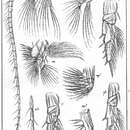en
names in breadcrumbs


Body opaque, with a faint bluish tint, may have patches of brown or reddish color
North Atlantic, Barents Sea, White Sea, Kara Sea. May occur in very large numbers.
Neritic, brackish species; occurs near the surface.
Female:
Body broadly oval in shape from dorsal view, the widest point of the cephalothorax is above the middle of the head. Abdomen about 2 times shoter than the cephalothorax. Caudal rami very long, with hairs on the inner edge. P5 small, uniramous, three-segmented, the distal segment contains 4 spines.
Male:
Right A1 geniculate. P5 asymmetrical; the left leg is more than twice larger than the left. The 2nd segment of the left leg with a large thumb-shaped growth. The distal segment of the right leg bent at a right angle at the base and carries a large spine on the outer edge.
Broadcast spawning species, do not carry egg sacs
Female: 0,80-1,66 mm
Male: 0,82-1,65 mm
Temora longicornis is a species of copepod in the family Temoridae. It is found in marine environments on both sides of the Atlantic Ocean.
In North America this copepod occurs between Cape Cod and Florida. In some years it is the commonest calanoid in the winter and spring in the mid-Atlantic region, and sometimes also in summer and autumn in Long Island Sound. It tends to be less abundant in estuaries than in open stretches of coast.[2]
Temora longicornis makes daily vertical migrations, spending the day near the seabed and the night near the surface.[2] Males can swim faster than females, and 3D tracking has shown that males can follow a detectable trail left by females. Sometimes they follow it in the wrong direction.[3]
This copepod is an omnivore; diatoms are a major part of the diet and phytoplankton is also grazed.[2] This copepod is preyed on heavily by the sand lance in the northwestern Atlantic.[2] It also forms an important part of the diet of the herring (Clupea harengus) and sprat (Sprattus sprattus) in the southern Baltic Sea in the autumn, at which time the copepods are particularly plentiful.[4]
This species' eggs float near the surface before they hatch and the developing larvae move deeper into the water column at each successive moult. The species has been shown to sometimes produce diapausing eggs in the summer months of June and July in Long Island Sound. When this happens, it results in a reduction in the quantity of zooplankton at that time of year. The eggs are buried in the sediment for a species-specific length of time and then hatch, moving into the water column as nauplius larvae as they develop. In the North Sea, dormancy takes place in winter.[5]
Temora longicornis is a species of copepod in the family Temoridae. It is found in marine environments on both sides of the Atlantic Ocean.
Temora longicornis is een eenoogkreeftjessoort uit de familie van de Temoridae.[1] De wetenschappelijke naam van de soort is voor het eerst geldig gepubliceerd in 1785 door Müller O.F..
Bronnen, noten en/of referentiesTemora longicornis é uma espécie de crustáceo, um copépode marinho da família Temoridae. Foi descrita pela primeira vez pelo zoólogo dinamarquês Otto Friedrich Müller em 1785. Os espécimes adultos medem cerca de 1 mm.[1]
A espécie é encontrada em ambientes marítimos em ambos os lados do Oceano Atlântico. Na América do Norte, sua distribuição vai da Flórida ao Cabo Cod. Em alguns anos, é o calanóide mais comum no meio de sua zona de distribuição durante o inverno e a primavera, e às vezes no Estuário de Long Island durante o verão e o outono. A espécie tende a ser mais abundante em costas de mar aberto do que em estuários.[2]
T. longicornis realiza migrações verticais diárias para evitar predadores, passando o dia próximos ao fundo do mar e a noite próximos à superfície. Machos se locomovem com mais velocidade do que as fêmeas, e rastreamento 3D revelou que eles são capazes de seguir uma trilha detectável deixada para trás pelas fêmeas, embora às vezes a sigam na direção contrária.[3]
Este copépode é um onívoro, alimentando-se principalmente de diatomáceas e também de fitoplâncton.[2] Os principais predadores do T. longicornis no Atlântico noroeste são os peixes da família Ammodytidae.[1] Além disso, durante o outono no Mar Báltico (quando esse copépode está em seu maior número populacional) a espécie compõe uma parte importante da dieta dos arenques e espadilhas.[4]
Os ovos da espécie normalmente flutuam até a superfície antes de eclodirem, e as larvas se movem em direção ao fundo a cada ecdise sucessiva. Ás vezes, os ovos da espécie permanecem em diapausa durante o verão no Estuário de Long Island. Quando isso ocorre, há uma diminuição no volume de zooplâncton naquele ano, enquanto os ovos permanecem enterrados no sedimento por certo tempo. No Mar do Norte, esse período de dormência ocorre no inverno.[5]
Temora longicornis é uma espécie de crustáceo, um copépode marinho da família Temoridae. Foi descrita pela primeira vez pelo zoólogo dinamarquês Otto Friedrich Müller em 1785. Os espécimes adultos medem cerca de 1 mm.